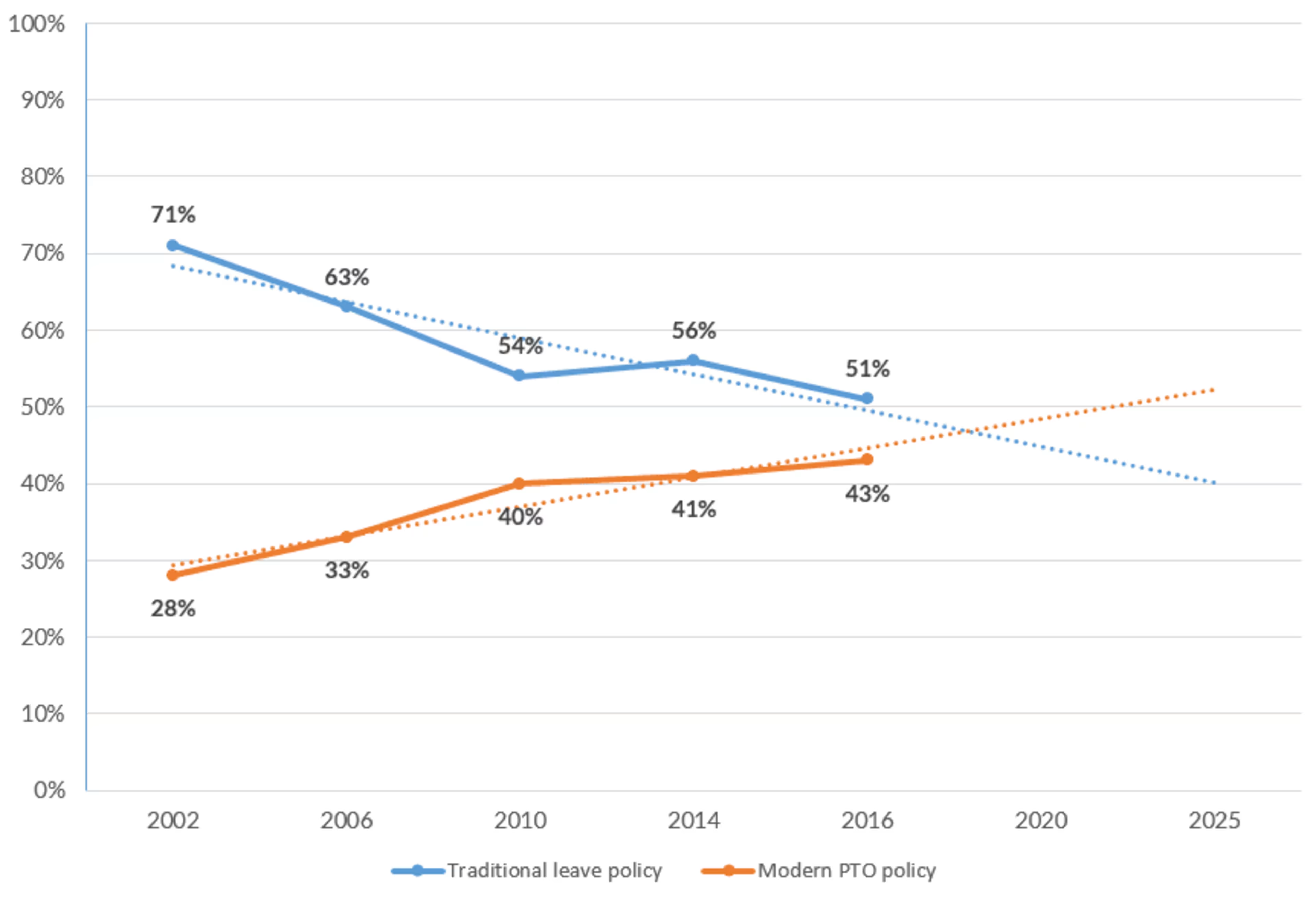"I have a stomach virus."
"I have a sore throat."
"I just can't stop coughing."
Employees send you a note they're out sick, and then they miraculously recover within a day or two. Managers watch this happen all the time.

As a manager, I'll admit: It happens. Employees really do get sick and are better in a day or two. Sometimes.
But when did it become "normal" to get an early morning email from an employee saying that they're sick when they really just need a day off? When did managers become the sick day police?
The concept of sick days was originally created to keep employees from abusing time off and to help track work environments in which employees were sick more frequently than other parts of the business.
I've experienced both sides of the situation. I've had to take unpaid sick leave as a part-time employee when I wasn't sick, and I've seen my direct reports scramble to make sure I knew they were taking sick leave.
The sick leave policy model is archaic and well past due for a tuneup. Business owners should move to a non-defined paid time off policy by 2020 to remain competitive with other small and midsize business (SMB) compensation packages.
In this article, I'll dive into PTO policy trends that have appeared over the past 15 years, how the traditional sick leave model hurts the employer-employee relationship, and how to form a modern, non-defined PTO policy that fosters positive workplace sentiments.
Smart business owners are already moving toward a modern PTO policy
World at Work surveyed 5,524 benefits specialists and found that the number of businesses that use a traditional leave policy (defining and allotting sick leave, vacation leave, and personal time) decreased from 71% in 2002 to 51% in 2016.
In contrast, the number of companies that use a modern PTO policy increased from 28% in 2002 to 43% in 2016.
I expect this trend to continue as employees ask for more flexibility in their work schedules. The number of companies adopting a modern PTO policy is on track to surpass those offering a traditional leave policy by 2020.

Trend of traditional leave policy versus modern PTO policy adoption in U.S. businesses (Source)
Let me set the record straight: Small businesses should still allocate a predetermined number of days off for their employees.
SMBs shouldn't, however, use the antiquated terms "sick days" or "sick leave," but should instead define all days off as paid time off (PTO).
Sick days force employees to compromise their integrity
Sometimes, people just need a day off.
This seems like a simple statement, but it's often regularly overlooked or reasoned away in small businesses.
Consider the breadth of ailments that aren't easily communicated through an email or phone call. Maybe an employee needs a mental health break, or they're worn out after a sleepless night, or they need to go to the DMV and don't have any extra vacation time.
I'd rather have my employees tell me that they need a day off than claiming a stomach flu when none exists. Relationships built on trust and mutual respect result in higher quality work and job dedication.
You can build a culture of honesty at your small business by removing the triggers for communicating via falsehoods.
Sick days encourage employees to feel guilty about needing a day off
Maybe it's just me, but when I was an employee in a high-stress job and needed a day off, I felt horrible for needing to take that time.
The possibility of being perceived as weak by my manager led to a guilt-ridden day off where I didn't get the relaxation I needed in the first place
Prescribing sick days makes employees feel like they should be sick when they need a day off. Sick as in the flu, not sick as in mentally tired.
Taking a day off shouldn't be seen as a weakness, but rather as a way for your employees to maintain their health, both physically and mentally. Consider this: Employees in the U.S. who are overworked have a similar mortality rate to those who are exposed to secondhand smoke. That's worrisome.
Morbidity rates expressed by physician-diagnosed health conditions related to secondhand smoke, high job demands, and long work hours from a meta-analysis of 228 studies assessing the effects of workplace stressors on health (Source)
Switching to the non-defined PTO model allows employees to say to their manager, "I'm taking the day off." No questions asked, no guilty feelings, and no adverse health effects.
Sick days put management in an awkward position
There are two sides to every story.
Of course, management needs to know why an employee isn't in the office when they are scheduled. However, do managers really need to know the reason if the behavior isn't habitual?
Great managers want to know what's going on in their employees' lives, but they also don't need to help perpetuate a lie or violate employee privacy.
By defining an employee's allocated time out of the office as PTO, "You're saying to staffers, it's PTO, just take it," according to Gretchen Van Vlymen, VP of Chicago HR consulting firm StratEX.
Employees don't have to come up with a reason, and managers don't have to worry that employees are lying to them.
4 ways to create a better work culture with no sick days
1. Write your PTO policies clearly
If you aren't going to differentiate between personal time and sick time, you need to make that clear when you write your PTO policy. Ensure your employees don't think that they get all of their personal time in addition to sick days.
And if your employees need to take more than their allocated PTO because of an illness? You'll have to follow provisions set forth by the Family and Medical Leave Act:
"The FMLA entitles eligible employees of covered employers to take unpaid, job-protected leave for specified family and medical reasons with continuation of group health insurance coverage under the same terms and conditions as if the employee had not taken leave."
2. Invest in time-tracking software
You need to know when your employees aren't working. That's simple.
But you also need to know when an employee shows patterns of using their leave, regardless of what it's for.
Use time-tracking software to determine if an employee is taking every Friday off to give themselves a three-day weekend to the detriment of your business or to see if they've exceeded their allotted number of days off.
If you identify any odd employee leave-taking behaviors, sit down with that employee and discuss what's going on in their lives. There could be something going on in their personal life that you don't know about, or it could be they aren't satisfied with their work. You won't know unless you ask.
3. Get to know your employees
Getting to know your employees does excellent things for the employer-employee relationship. It helps you recognize work patterns and identify quirks that improve your working relationship.
Getting to know each other also helps you recognize when an employee is acting "off" and potentially needs a break.
There's no way to know if your employee is taking their PTO for a family loss or because they're burnt out unless they tell you. Either way, it's better to know how to help your employees instead of penalizing them for using their time off.
Not sure how to start? Check out this great resource for getting to know your employees better.
4. Define 'PTO abuse' early
PTO is not a right.
Unless they're a U.S. government employee or contractor, employers aren't required to provide PTO to workers. According to the Department of Labor:
"The Fair Labor Standards Act (FLSA) does not require payment for time not worked, such as vacations, sick leave or federal or other holidays. These benefits are matters of agreement between an employer and an employee (or the employee's representative)."
This means that when you write 20 PTO days into an employee's contract, it's a reward for exceptional work or a perk for agreeing to employment. Sure, this is standard for most full-time jobs these days, but it remains true that small business owners don't have to pay employees for days they don't work.
Combined, these facts can lead to PTO abuse. It's going to happen. Eventually, every small business owner encounters that one entitled employee who wants to work at their leisure, regardless of the company's PTO policies.
The key to avoiding PTO abuse is to define what "abuse" means from the outset. Perhaps your policy says that PTO can't be used on more than three consecutive Fridays without permission or that an absence of more than three days needs to be relayed in advance so the team can prepare. Make sure your employees know what is acceptable, and what isn't.
Remember though, don't be too strict in your definitions, or you'll hurt the overall goal of work flexibility.
When you want to change your PTO policy, consult a labor law expert
Labor law is extraordinarily complicated, and you could be held liable if your PTO policies aren't crafted correctly.
Consider your small business's current PTO policies and adjust them to a more modern policy for the betterment of your employees. Before engaging in a full revamp, though, do your due diligence and consult a labor attorney on how to restructure your PTO policies.
Want to do some more research on the right time keeping software for your small business? Start with this article: